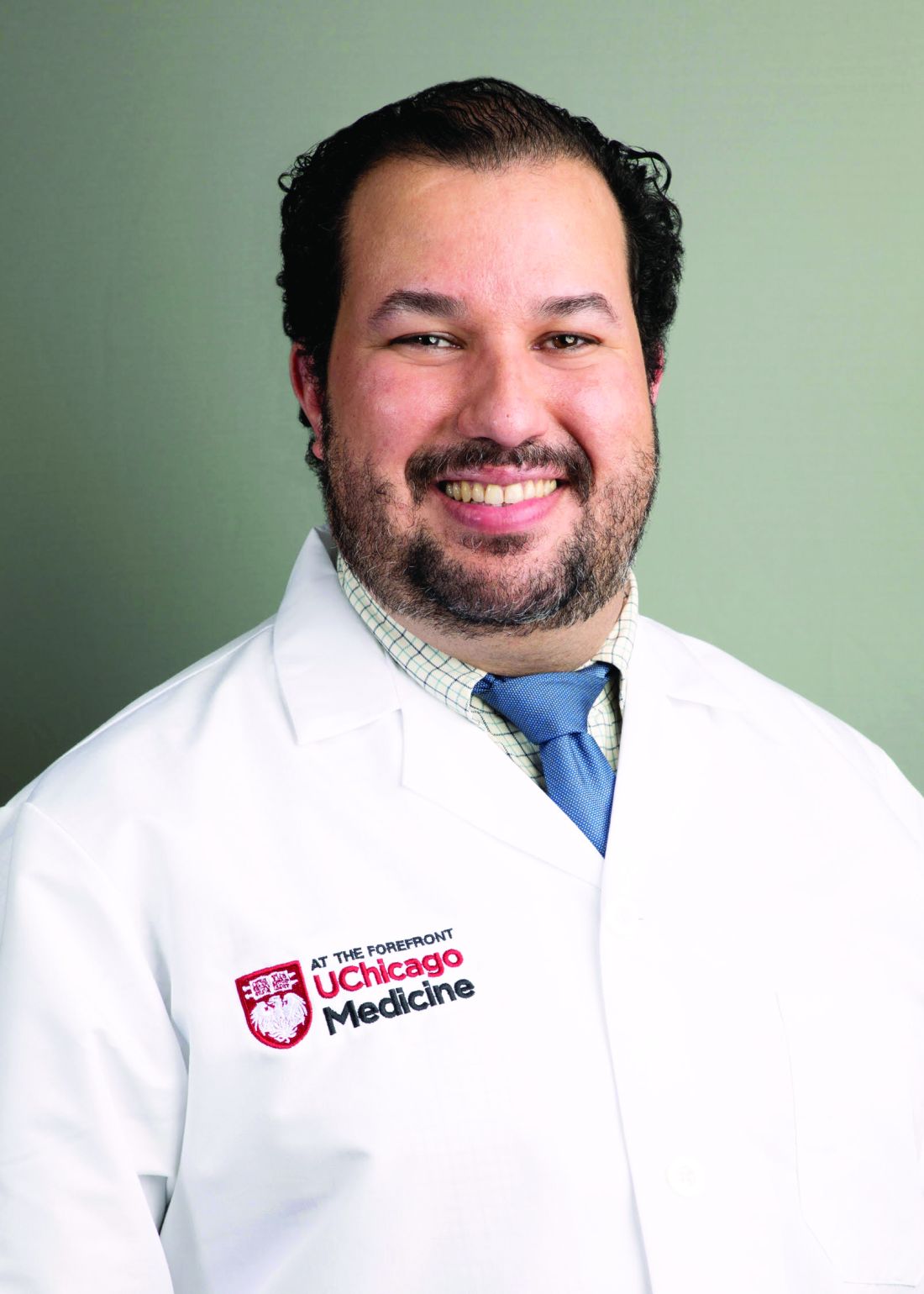User login
Revival of the aspiration vs chest tube debate for PSP
Thoracic Oncology and Chest Procedures Network
Pleural Disease Section
Considerable heterogeneity exists in the management of primary spontaneous pneumothorax (PSP). American and European guidelines have been grappling with this question for decades: What is the best way to manage PSP? A 2023 randomized, controlled trial (Marx et al. AJRCCM) sought to answer this.
The study recruited 379 adults aged 18 to 55 years between 2009 and 2015, with complete and first PSP in 31 French hospitals. One hundred eighty-nine patients initially received simple aspiration and 190 received chest tube drainage. The aspiration device was removed if a chest radiograph (CXR) following 30 minutes of aspiration showed lung apposition, with suction repeated up to one time with incomplete re-expansion. The chest tubes were large-bore (16-F or 20-F) and removed 72 hours postprocedure if the CXR showed complete lung re-expansion.
Simple aspiration was statistically inferior to chest tube drainage (29% vs 18%). However, first-line simple aspiration resulted in shorter length of stay, less subcutaneous emphysema, site infection, pain, and one-year recurrence.
Since most first-time PSP occurs in younger, healthier adults, simple aspiration could still be considered as it is better tolerated than large-bore chest tubes. However, with more frequent use of small-bore (≤14-F) catheters, ambulatory drainage could also be a suitable option in carefully selected patients. Additionally, inpatient chest tubes do not need to remain in place for 72 hours, as was this study’s protocol. Society guidelines will need to weigh in on the latest high-quality evidence available for final recommendations.
Thoracic Oncology and Chest Procedures Network
Pleural Disease Section
Considerable heterogeneity exists in the management of primary spontaneous pneumothorax (PSP). American and European guidelines have been grappling with this question for decades: What is the best way to manage PSP? A 2023 randomized, controlled trial (Marx et al. AJRCCM) sought to answer this.
The study recruited 379 adults aged 18 to 55 years between 2009 and 2015, with complete and first PSP in 31 French hospitals. One hundred eighty-nine patients initially received simple aspiration and 190 received chest tube drainage. The aspiration device was removed if a chest radiograph (CXR) following 30 minutes of aspiration showed lung apposition, with suction repeated up to one time with incomplete re-expansion. The chest tubes were large-bore (16-F or 20-F) and removed 72 hours postprocedure if the CXR showed complete lung re-expansion.
Simple aspiration was statistically inferior to chest tube drainage (29% vs 18%). However, first-line simple aspiration resulted in shorter length of stay, less subcutaneous emphysema, site infection, pain, and one-year recurrence.
Since most first-time PSP occurs in younger, healthier adults, simple aspiration could still be considered as it is better tolerated than large-bore chest tubes. However, with more frequent use of small-bore (≤14-F) catheters, ambulatory drainage could also be a suitable option in carefully selected patients. Additionally, inpatient chest tubes do not need to remain in place for 72 hours, as was this study’s protocol. Society guidelines will need to weigh in on the latest high-quality evidence available for final recommendations.
Thoracic Oncology and Chest Procedures Network
Pleural Disease Section
Considerable heterogeneity exists in the management of primary spontaneous pneumothorax (PSP). American and European guidelines have been grappling with this question for decades: What is the best way to manage PSP? A 2023 randomized, controlled trial (Marx et al. AJRCCM) sought to answer this.
The study recruited 379 adults aged 18 to 55 years between 2009 and 2015, with complete and first PSP in 31 French hospitals. One hundred eighty-nine patients initially received simple aspiration and 190 received chest tube drainage. The aspiration device was removed if a chest radiograph (CXR) following 30 minutes of aspiration showed lung apposition, with suction repeated up to one time with incomplete re-expansion. The chest tubes were large-bore (16-F or 20-F) and removed 72 hours postprocedure if the CXR showed complete lung re-expansion.
Simple aspiration was statistically inferior to chest tube drainage (29% vs 18%). However, first-line simple aspiration resulted in shorter length of stay, less subcutaneous emphysema, site infection, pain, and one-year recurrence.
Since most first-time PSP occurs in younger, healthier adults, simple aspiration could still be considered as it is better tolerated than large-bore chest tubes. However, with more frequent use of small-bore (≤14-F) catheters, ambulatory drainage could also be a suitable option in carefully selected patients. Additionally, inpatient chest tubes do not need to remain in place for 72 hours, as was this study’s protocol. Society guidelines will need to weigh in on the latest high-quality evidence available for final recommendations.
AI applications in pediatric pulmonary, sleep, and critical care medicine
Airways Disorders Network
Pediatric Chest Medicine Section
Artificial intelligence (AI) refers to the science and engineering of making intelligent machines that mimic human cognitive functions, such as learning and problem solving.1 Asthma exacerbations in young children were detected reliably by AI-aided stethoscope alone.2 Inhaler use has been successfully tracked using active and passive patient input to cloud-based dashboards.3 Asthma specialists can potentially use this knowledge to intervene in real time or more frequent intervals than the current episodic care.
Sleep trackers using commercial-grade sensors can provide useful information about sleep hygiene, sleep duration, and nocturnal awakenings. An increasing number of “wearables” and “nearables” that utilize AI algorithms to evaluate sleep duration and quality are FDA approved. AI-based scoring of polysomnography data can improve the efficiency of a sleep laboratory. Big data analysis of CPAP compliance in children led to identification of actionable items that can be targeted to improve patient outcomes.4
The use of AI models in clinical decision support can result in fewer false alerts and missed patients due to increased model accuracy. Additionally, large language model tools can automatically generate comprehensive progress notes incorporating relevant electronic medical records data, thereby reducing physician charting time.
These case uses highlight the potential to improve workflow efficiency and clinical outcomes in pediatric pulmonary and critical care by incorporating AI tools in medical decision-making and management.
References
1. McCarthy JF, Marx KA, Hoffman PE, et al. Applications of machine learning and high-dimensional visualization in cancer detection, diagnosis, and management. Ann N Y Acad Sci. 2004;1020:239-262.
2. Emeryk A, Derom E, Janeczek K, et al. Home monitoring of asthma exacerbations in children and adults with use of an AI-aided stethoscope. Ann Fam Med. 2023;21(6):517-525.
3. Jaimini U, Thirunarayan K, Kalra M, Venkataraman R, Kadariya D, Sheth A. How is my child’s asthma?” Digital phenotype and actionable insights for pediatric asthma. JMIR Pediatr Parent. 2018;1(2):e11988.
4. Bhattacharjee R, Benjafield AV, Armitstead J, et al. Adherence in children using positive airway pressure therapy: a big-data analysis [published correction appears in Lancet Digit Health. 2020 Sep;2(9):e455.]. Lancet Digit Health. 2020;2(2):e94-e101.
Airways Disorders Network
Pediatric Chest Medicine Section
Artificial intelligence (AI) refers to the science and engineering of making intelligent machines that mimic human cognitive functions, such as learning and problem solving.1 Asthma exacerbations in young children were detected reliably by AI-aided stethoscope alone.2 Inhaler use has been successfully tracked using active and passive patient input to cloud-based dashboards.3 Asthma specialists can potentially use this knowledge to intervene in real time or more frequent intervals than the current episodic care.
Sleep trackers using commercial-grade sensors can provide useful information about sleep hygiene, sleep duration, and nocturnal awakenings. An increasing number of “wearables” and “nearables” that utilize AI algorithms to evaluate sleep duration and quality are FDA approved. AI-based scoring of polysomnography data can improve the efficiency of a sleep laboratory. Big data analysis of CPAP compliance in children led to identification of actionable items that can be targeted to improve patient outcomes.4
The use of AI models in clinical decision support can result in fewer false alerts and missed patients due to increased model accuracy. Additionally, large language model tools can automatically generate comprehensive progress notes incorporating relevant electronic medical records data, thereby reducing physician charting time.
These case uses highlight the potential to improve workflow efficiency and clinical outcomes in pediatric pulmonary and critical care by incorporating AI tools in medical decision-making and management.
References
1. McCarthy JF, Marx KA, Hoffman PE, et al. Applications of machine learning and high-dimensional visualization in cancer detection, diagnosis, and management. Ann N Y Acad Sci. 2004;1020:239-262.
2. Emeryk A, Derom E, Janeczek K, et al. Home monitoring of asthma exacerbations in children and adults with use of an AI-aided stethoscope. Ann Fam Med. 2023;21(6):517-525.
3. Jaimini U, Thirunarayan K, Kalra M, Venkataraman R, Kadariya D, Sheth A. How is my child’s asthma?” Digital phenotype and actionable insights for pediatric asthma. JMIR Pediatr Parent. 2018;1(2):e11988.
4. Bhattacharjee R, Benjafield AV, Armitstead J, et al. Adherence in children using positive airway pressure therapy: a big-data analysis [published correction appears in Lancet Digit Health. 2020 Sep;2(9):e455.]. Lancet Digit Health. 2020;2(2):e94-e101.
Airways Disorders Network
Pediatric Chest Medicine Section
Artificial intelligence (AI) refers to the science and engineering of making intelligent machines that mimic human cognitive functions, such as learning and problem solving.1 Asthma exacerbations in young children were detected reliably by AI-aided stethoscope alone.2 Inhaler use has been successfully tracked using active and passive patient input to cloud-based dashboards.3 Asthma specialists can potentially use this knowledge to intervene in real time or more frequent intervals than the current episodic care.
Sleep trackers using commercial-grade sensors can provide useful information about sleep hygiene, sleep duration, and nocturnal awakenings. An increasing number of “wearables” and “nearables” that utilize AI algorithms to evaluate sleep duration and quality are FDA approved. AI-based scoring of polysomnography data can improve the efficiency of a sleep laboratory. Big data analysis of CPAP compliance in children led to identification of actionable items that can be targeted to improve patient outcomes.4
The use of AI models in clinical decision support can result in fewer false alerts and missed patients due to increased model accuracy. Additionally, large language model tools can automatically generate comprehensive progress notes incorporating relevant electronic medical records data, thereby reducing physician charting time.
These case uses highlight the potential to improve workflow efficiency and clinical outcomes in pediatric pulmonary and critical care by incorporating AI tools in medical decision-making and management.
References
1. McCarthy JF, Marx KA, Hoffman PE, et al. Applications of machine learning and high-dimensional visualization in cancer detection, diagnosis, and management. Ann N Y Acad Sci. 2004;1020:239-262.
2. Emeryk A, Derom E, Janeczek K, et al. Home monitoring of asthma exacerbations in children and adults with use of an AI-aided stethoscope. Ann Fam Med. 2023;21(6):517-525.
3. Jaimini U, Thirunarayan K, Kalra M, Venkataraman R, Kadariya D, Sheth A. How is my child’s asthma?” Digital phenotype and actionable insights for pediatric asthma. JMIR Pediatr Parent. 2018;1(2):e11988.
4. Bhattacharjee R, Benjafield AV, Armitstead J, et al. Adherence in children using positive airway pressure therapy: a big-data analysis [published correction appears in Lancet Digit Health. 2020 Sep;2(9):e455.]. Lancet Digit Health. 2020;2(2):e94-e101.
Mechanical power: A missing piece in lung-protective ventilation?
Critical Care Network
Mechanical Ventilation and Airways Management Section
The ARDSNet trial demonstrated the importance of low tidal volume ventilation in patients with ARDS, and we have learned to monitor parameters such as plateau pressure and driving pressure (DP) to ensure lung-protective ventilation. What role does the higher respiratory rate play? There is growing evidence that respiratory rate may play an important part in the pathogenesis of ventilator-induced lung injury (VILI) and the dynamic effect of both rate and static pressures needs to be evaluated.
The concept of mechanical power (MP) was formalized in 2016 by Gattinoni, et al and defined as the product of respiratory rate and total inflation energy gained per breath.1 Calculations have been developed for both volume-controlled and pressure-controlled ventilation, including elements such as respiratory rate and PEEP. Studies have shown that increased MP is associated with ICU and hospital mortality, even at low tidal volumes.2 The use of MP remains limited in clinical practice due to its dynamic nature and difficulty of calculating in routine clinical practice but may be a feasible addition to the continuous monitoring outputs on a ventilator. Additional prospective studies are also needed to define the optimal threshold of MP and to compare monitoring strategies using MP vs DP.
References
1. Gattinoni L, Tonetti T, Cressoni M, et al. Ventilator-related causes of lung injury: the mechanical power. Intensive Care Med. 2016;42(10):1567-1575.
2. Serpa Neto A, Deliberato RO, Johnson AEW, et al. Mechanical power of ventilation is associated with mortality in critically ill patients: an analysis of patients in two observational cohorts. Intensive Care Med. 2018;44(11):1914-1922.
Critical Care Network
Mechanical Ventilation and Airways Management Section
The ARDSNet trial demonstrated the importance of low tidal volume ventilation in patients with ARDS, and we have learned to monitor parameters such as plateau pressure and driving pressure (DP) to ensure lung-protective ventilation. What role does the higher respiratory rate play? There is growing evidence that respiratory rate may play an important part in the pathogenesis of ventilator-induced lung injury (VILI) and the dynamic effect of both rate and static pressures needs to be evaluated.
The concept of mechanical power (MP) was formalized in 2016 by Gattinoni, et al and defined as the product of respiratory rate and total inflation energy gained per breath.1 Calculations have been developed for both volume-controlled and pressure-controlled ventilation, including elements such as respiratory rate and PEEP. Studies have shown that increased MP is associated with ICU and hospital mortality, even at low tidal volumes.2 The use of MP remains limited in clinical practice due to its dynamic nature and difficulty of calculating in routine clinical practice but may be a feasible addition to the continuous monitoring outputs on a ventilator. Additional prospective studies are also needed to define the optimal threshold of MP and to compare monitoring strategies using MP vs DP.
References
1. Gattinoni L, Tonetti T, Cressoni M, et al. Ventilator-related causes of lung injury: the mechanical power. Intensive Care Med. 2016;42(10):1567-1575.
2. Serpa Neto A, Deliberato RO, Johnson AEW, et al. Mechanical power of ventilation is associated with mortality in critically ill patients: an analysis of patients in two observational cohorts. Intensive Care Med. 2018;44(11):1914-1922.
Critical Care Network
Mechanical Ventilation and Airways Management Section
The ARDSNet trial demonstrated the importance of low tidal volume ventilation in patients with ARDS, and we have learned to monitor parameters such as plateau pressure and driving pressure (DP) to ensure lung-protective ventilation. What role does the higher respiratory rate play? There is growing evidence that respiratory rate may play an important part in the pathogenesis of ventilator-induced lung injury (VILI) and the dynamic effect of both rate and static pressures needs to be evaluated.
The concept of mechanical power (MP) was formalized in 2016 by Gattinoni, et al and defined as the product of respiratory rate and total inflation energy gained per breath.1 Calculations have been developed for both volume-controlled and pressure-controlled ventilation, including elements such as respiratory rate and PEEP. Studies have shown that increased MP is associated with ICU and hospital mortality, even at low tidal volumes.2 The use of MP remains limited in clinical practice due to its dynamic nature and difficulty of calculating in routine clinical practice but may be a feasible addition to the continuous monitoring outputs on a ventilator. Additional prospective studies are also needed to define the optimal threshold of MP and to compare monitoring strategies using MP vs DP.
References
1. Gattinoni L, Tonetti T, Cressoni M, et al. Ventilator-related causes of lung injury: the mechanical power. Intensive Care Med. 2016;42(10):1567-1575.
2. Serpa Neto A, Deliberato RO, Johnson AEW, et al. Mechanical power of ventilation is associated with mortality in critically ill patients: an analysis of patients in two observational cohorts. Intensive Care Med. 2018;44(11):1914-1922.
Major takeaways from the seventh world symposium on PH
Pulmonary Vascular and Cardiovascular Network
Pulmonary Vascular Disease Section
The core definition of pulmonary hypertension (PH) remains a mean pulmonary arterial pressure (mPAP) > 20 mm Hg, with precapillary PH defined by a pulmonary arterial wedge pressure (PCWP) ≤ 15 mm Hg and pulmonary vascular resistance (PVR) > 2 Wood units (WU), similar to the 2022 European guidelines.1,2 There was recognition of uncertainty in patients with borderline PAWP (12-18 mm Hg) for postcapillary PH.
It’s crucial to phenotype patients, especially those with valvular heart disease, hypertrophic cardiomyopathy, or amyloid cardiomyopathy, and to be cautious when using PAH medications for this PH group.3
Group 3 PH is often underrecognized and associated with poor outcomes, so screening in clinically stable patients is recommended using a multimodal assessment before hemodynamic evaluation. Inhaled treprostinil is recommended for PH associated with interstitial lung disease (ILD). However, the PERFECT trial on PH therapy in COPD was stopped due to safety concerns, highlighting the need for careful evaluation in chronic lung disease (CLD) patients.4 For risk stratification, further emphasis was made on cardiac imaging and hemodynamic data.
Significant progress was made in understanding four key pathways, including bone morphogenetic protein (BMP)/activin signaling. A treatment algorithm based on risk stratification was reinforced, recommending initial triple therapy with parenteral prostacyclin analogs for high-risk patients.5 Follow-up reassessment may include adding an activin-signaling inhibitor for all risk groups except low risk, as well as oral or inhaled prostacyclin for intermediate-low risk groups.
References
1. Kovacs G, Bartolome S, Denton CP, et al. Definition, classification and diagnosis of pulmonary hypertension. Eur Respir J. 2024;2401324. (Online ahead of print.)
2. Humbert M, Kovacs G, Hoeper MM, et al. 2022 ESC/ERS Guidelines for the diagnosis and treatment of pulmonary hypertension. Eur Respir J. 2024;61(1):2200879.
3. Maron BA, Bortman G, De Marco T, et al. Pulmonary hypertension associated with left heart disease. Eur Respir J. 2024;2401344. (Online ahead of print.)
4. Shlobin OA, Adir Y, Barbera JA, et al. Pulmonary hypertension associated with lung diseases. Eur Respir J. 2024;2401200. (Online ahead of print.)
5. Chin KM, Gaine SP, Gerges C, et al. Treatment algorithm for pulmonary arterial hypertension. Eur Respir J. 2024;2401325. (Online ahead of print.)
Pulmonary Vascular and Cardiovascular Network
Pulmonary Vascular Disease Section
The core definition of pulmonary hypertension (PH) remains a mean pulmonary arterial pressure (mPAP) > 20 mm Hg, with precapillary PH defined by a pulmonary arterial wedge pressure (PCWP) ≤ 15 mm Hg and pulmonary vascular resistance (PVR) > 2 Wood units (WU), similar to the 2022 European guidelines.1,2 There was recognition of uncertainty in patients with borderline PAWP (12-18 mm Hg) for postcapillary PH.
It’s crucial to phenotype patients, especially those with valvular heart disease, hypertrophic cardiomyopathy, or amyloid cardiomyopathy, and to be cautious when using PAH medications for this PH group.3
Group 3 PH is often underrecognized and associated with poor outcomes, so screening in clinically stable patients is recommended using a multimodal assessment before hemodynamic evaluation. Inhaled treprostinil is recommended for PH associated with interstitial lung disease (ILD). However, the PERFECT trial on PH therapy in COPD was stopped due to safety concerns, highlighting the need for careful evaluation in chronic lung disease (CLD) patients.4 For risk stratification, further emphasis was made on cardiac imaging and hemodynamic data.
Significant progress was made in understanding four key pathways, including bone morphogenetic protein (BMP)/activin signaling. A treatment algorithm based on risk stratification was reinforced, recommending initial triple therapy with parenteral prostacyclin analogs for high-risk patients.5 Follow-up reassessment may include adding an activin-signaling inhibitor for all risk groups except low risk, as well as oral or inhaled prostacyclin for intermediate-low risk groups.
References
1. Kovacs G, Bartolome S, Denton CP, et al. Definition, classification and diagnosis of pulmonary hypertension. Eur Respir J. 2024;2401324. (Online ahead of print.)
2. Humbert M, Kovacs G, Hoeper MM, et al. 2022 ESC/ERS Guidelines for the diagnosis and treatment of pulmonary hypertension. Eur Respir J. 2024;61(1):2200879.
3. Maron BA, Bortman G, De Marco T, et al. Pulmonary hypertension associated with left heart disease. Eur Respir J. 2024;2401344. (Online ahead of print.)
4. Shlobin OA, Adir Y, Barbera JA, et al. Pulmonary hypertension associated with lung diseases. Eur Respir J. 2024;2401200. (Online ahead of print.)
5. Chin KM, Gaine SP, Gerges C, et al. Treatment algorithm for pulmonary arterial hypertension. Eur Respir J. 2024;2401325. (Online ahead of print.)
Pulmonary Vascular and Cardiovascular Network
Pulmonary Vascular Disease Section
The core definition of pulmonary hypertension (PH) remains a mean pulmonary arterial pressure (mPAP) > 20 mm Hg, with precapillary PH defined by a pulmonary arterial wedge pressure (PCWP) ≤ 15 mm Hg and pulmonary vascular resistance (PVR) > 2 Wood units (WU), similar to the 2022 European guidelines.1,2 There was recognition of uncertainty in patients with borderline PAWP (12-18 mm Hg) for postcapillary PH.
It’s crucial to phenotype patients, especially those with valvular heart disease, hypertrophic cardiomyopathy, or amyloid cardiomyopathy, and to be cautious when using PAH medications for this PH group.3
Group 3 PH is often underrecognized and associated with poor outcomes, so screening in clinically stable patients is recommended using a multimodal assessment before hemodynamic evaluation. Inhaled treprostinil is recommended for PH associated with interstitial lung disease (ILD). However, the PERFECT trial on PH therapy in COPD was stopped due to safety concerns, highlighting the need for careful evaluation in chronic lung disease (CLD) patients.4 For risk stratification, further emphasis was made on cardiac imaging and hemodynamic data.
Significant progress was made in understanding four key pathways, including bone morphogenetic protein (BMP)/activin signaling. A treatment algorithm based on risk stratification was reinforced, recommending initial triple therapy with parenteral prostacyclin analogs for high-risk patients.5 Follow-up reassessment may include adding an activin-signaling inhibitor for all risk groups except low risk, as well as oral or inhaled prostacyclin for intermediate-low risk groups.
References
1. Kovacs G, Bartolome S, Denton CP, et al. Definition, classification and diagnosis of pulmonary hypertension. Eur Respir J. 2024;2401324. (Online ahead of print.)
2. Humbert M, Kovacs G, Hoeper MM, et al. 2022 ESC/ERS Guidelines for the diagnosis and treatment of pulmonary hypertension. Eur Respir J. 2024;61(1):2200879.
3. Maron BA, Bortman G, De Marco T, et al. Pulmonary hypertension associated with left heart disease. Eur Respir J. 2024;2401344. (Online ahead of print.)
4. Shlobin OA, Adir Y, Barbera JA, et al. Pulmonary hypertension associated with lung diseases. Eur Respir J. 2024;2401200. (Online ahead of print.)
5. Chin KM, Gaine SP, Gerges C, et al. Treatment algorithm for pulmonary arterial hypertension. Eur Respir J. 2024;2401325. (Online ahead of print.)
Extending exercise testing using telehealth monitoring in patients with ILD
Diffuse Lung Disease and Lung Transplant Network
Pulmonary Physiology and Rehabilitation Section
The COVID-19 pandemic revolutionized the use of monitoring equipment in general and oxygen saturation monitoring devices as pulse oximeters in specific. The increasing adoption of activity trackers is geared toward promoting an active lifestyle through real-time feedback and continuous monitoring. Patients with interstitial lung diseases (ILDs) suffer from different symptoms; one of the most disabling is dyspnea. Primarily associated with oxygen desaturation, it initiates a detrimental cycle of decreased physical activity, ultimately compromising the overall quality of life.
The use of activity trackers has shown to enhance exercise capacity among ILD and sarcoidosis patients.1
Implementing continuous monitor activity by activity trackers coupled with continuous oxygen saturation can provide a comprehensive tool to follow up with ILD patients efficiently and accurately based on established use of a six-minute walk test (6MWT) and desaturation screen. Combined 6MWT and desaturation screens remain the principal predictors to assess the disease progression and treatment response in a variety of lung diseases, mainly pulmonary hypertension and ILD and serve as a prognostic indicator of those patients.2 One of the test limitations is that the distance walked in six minutes reflects fluctuations in quality of life.3 Also, the test measures submaximal exercise performance rather than maximal exercise capacity.4
Associations have been found in that the amplitude of oxygen desaturation at the end of exercise was poorly reproducible in 6MWT in idiopathic Interstitial pneumonia.5
Considering the mentioned limitations of the classic 6MWT, an alternative approach involves extended desaturation screen using telehealth and involving different activity levels. However, further validation across a diverse spectrum of ILDs remains essential.
References
1. Cho PSP, Vasudevan S, Maddocks M, et al. Physical inactivity in pulmonary sarcoidosis. Lung. 2019;197(3):285-293.
2. Flaherty KR, Andrei AC, Murray S, et al. Idiopathic pulmonary fibrosis: prognostic value of changes in physiology and six-minute-walk test. Am J Respir Crit Care Med. 2006;174(7), 803-809.
3. Olsson LG, Swedberg K, Clark AL, Witte KK, Cleland JG. Six-minute corridor walk test as an outcome measure for the assessment of treatment in randomized, blinded intervention trials of chronic heart failure: a systematic review. Eur Heart J. 2005;26(8):778-793.
4. Ingle L, Wilkinson M, Carroll S, et al. Cardiorespiratory requirements of the 6-min walk test in older patients with left ventricular systolic dysfunction and no major structural heart disease. Int J Sports Med. 2007;28(8):678-684. https://doi.org/10.1055/s-2007-964886
5. Eaton T, Young P, Milne D, Wells AU. Six-minute walk, maximal exercise tests: reproducibility in fibrotic interstitial pneumonia. Am J Respir Crit Care Med. 2005;171(10):1150-1157.
Diffuse Lung Disease and Lung Transplant Network
Pulmonary Physiology and Rehabilitation Section
The COVID-19 pandemic revolutionized the use of monitoring equipment in general and oxygen saturation monitoring devices as pulse oximeters in specific. The increasing adoption of activity trackers is geared toward promoting an active lifestyle through real-time feedback and continuous monitoring. Patients with interstitial lung diseases (ILDs) suffer from different symptoms; one of the most disabling is dyspnea. Primarily associated with oxygen desaturation, it initiates a detrimental cycle of decreased physical activity, ultimately compromising the overall quality of life.
The use of activity trackers has shown to enhance exercise capacity among ILD and sarcoidosis patients.1
Implementing continuous monitor activity by activity trackers coupled with continuous oxygen saturation can provide a comprehensive tool to follow up with ILD patients efficiently and accurately based on established use of a six-minute walk test (6MWT) and desaturation screen. Combined 6MWT and desaturation screens remain the principal predictors to assess the disease progression and treatment response in a variety of lung diseases, mainly pulmonary hypertension and ILD and serve as a prognostic indicator of those patients.2 One of the test limitations is that the distance walked in six minutes reflects fluctuations in quality of life.3 Also, the test measures submaximal exercise performance rather than maximal exercise capacity.4
Associations have been found in that the amplitude of oxygen desaturation at the end of exercise was poorly reproducible in 6MWT in idiopathic Interstitial pneumonia.5
Considering the mentioned limitations of the classic 6MWT, an alternative approach involves extended desaturation screen using telehealth and involving different activity levels. However, further validation across a diverse spectrum of ILDs remains essential.
References
1. Cho PSP, Vasudevan S, Maddocks M, et al. Physical inactivity in pulmonary sarcoidosis. Lung. 2019;197(3):285-293.
2. Flaherty KR, Andrei AC, Murray S, et al. Idiopathic pulmonary fibrosis: prognostic value of changes in physiology and six-minute-walk test. Am J Respir Crit Care Med. 2006;174(7), 803-809.
3. Olsson LG, Swedberg K, Clark AL, Witte KK, Cleland JG. Six-minute corridor walk test as an outcome measure for the assessment of treatment in randomized, blinded intervention trials of chronic heart failure: a systematic review. Eur Heart J. 2005;26(8):778-793.
4. Ingle L, Wilkinson M, Carroll S, et al. Cardiorespiratory requirements of the 6-min walk test in older patients with left ventricular systolic dysfunction and no major structural heart disease. Int J Sports Med. 2007;28(8):678-684. https://doi.org/10.1055/s-2007-964886
5. Eaton T, Young P, Milne D, Wells AU. Six-minute walk, maximal exercise tests: reproducibility in fibrotic interstitial pneumonia. Am J Respir Crit Care Med. 2005;171(10):1150-1157.
Diffuse Lung Disease and Lung Transplant Network
Pulmonary Physiology and Rehabilitation Section
The COVID-19 pandemic revolutionized the use of monitoring equipment in general and oxygen saturation monitoring devices as pulse oximeters in specific. The increasing adoption of activity trackers is geared toward promoting an active lifestyle through real-time feedback and continuous monitoring. Patients with interstitial lung diseases (ILDs) suffer from different symptoms; one of the most disabling is dyspnea. Primarily associated with oxygen desaturation, it initiates a detrimental cycle of decreased physical activity, ultimately compromising the overall quality of life.
The use of activity trackers has shown to enhance exercise capacity among ILD and sarcoidosis patients.1
Implementing continuous monitor activity by activity trackers coupled with continuous oxygen saturation can provide a comprehensive tool to follow up with ILD patients efficiently and accurately based on established use of a six-minute walk test (6MWT) and desaturation screen. Combined 6MWT and desaturation screens remain the principal predictors to assess the disease progression and treatment response in a variety of lung diseases, mainly pulmonary hypertension and ILD and serve as a prognostic indicator of those patients.2 One of the test limitations is that the distance walked in six minutes reflects fluctuations in quality of life.3 Also, the test measures submaximal exercise performance rather than maximal exercise capacity.4
Associations have been found in that the amplitude of oxygen desaturation at the end of exercise was poorly reproducible in 6MWT in idiopathic Interstitial pneumonia.5
Considering the mentioned limitations of the classic 6MWT, an alternative approach involves extended desaturation screen using telehealth and involving different activity levels. However, further validation across a diverse spectrum of ILDs remains essential.
References
1. Cho PSP, Vasudevan S, Maddocks M, et al. Physical inactivity in pulmonary sarcoidosis. Lung. 2019;197(3):285-293.
2. Flaherty KR, Andrei AC, Murray S, et al. Idiopathic pulmonary fibrosis: prognostic value of changes in physiology and six-minute-walk test. Am J Respir Crit Care Med. 2006;174(7), 803-809.
3. Olsson LG, Swedberg K, Clark AL, Witte KK, Cleland JG. Six-minute corridor walk test as an outcome measure for the assessment of treatment in randomized, blinded intervention trials of chronic heart failure: a systematic review. Eur Heart J. 2005;26(8):778-793.
4. Ingle L, Wilkinson M, Carroll S, et al. Cardiorespiratory requirements of the 6-min walk test in older patients with left ventricular systolic dysfunction and no major structural heart disease. Int J Sports Med. 2007;28(8):678-684. https://doi.org/10.1055/s-2007-964886
5. Eaton T, Young P, Milne D, Wells AU. Six-minute walk, maximal exercise tests: reproducibility in fibrotic interstitial pneumonia. Am J Respir Crit Care Med. 2005;171(10):1150-1157.
Sleep and athletic performance
Sleep Medicine Network
Respiratory-Related Sleep Disorders Section
Considering the recent Olympics, it is timely to review the importance of sleep for optimal athletic performance. When surveyed, 20% to 50% of athletes report poor or insufficient sleep, with consequences across four categories.1,2
Athletic performance: Objective measures of athletic performance, such as oxygen-carrying capacity during cardiopulmonary exercise and even sport-specific accuracy measures, like shooting percentage in basketball, have been shown to worsen with decreased sleep.
Decision-making: Insufficient sleep can impact split-second decisions in competition. In a study of male soccer players, sleep restriction negatively impacted perceptual abilities and reaction time. Traveling across time zones also appears to degrade performance; NBA players’ free-throw shooting worsens when they are jet-lagged.
Recovery and injury prevention: Getting less than eight hours of sleep may increase one’s chances of injury during performance. Sleepiness and insomnia are both independent risk factors for developing a concussion in college athletes and outperform more intuitive risk factors such as a history of prior concussion or participating in a high-risk sport. Impaired sleep directly alters secretion of growth hormone, cortisol, and proinflammatory cytokines—all of which can hinder recovery.
Mental health: Over a third of elite athletes are estimated to experience a mental health problem. A clear bidirectional relationship exists between mental health and sleep health, with important implications not only for optimal competitive mindset but also longevity and success over one’s career.
Although much of clinical sleep medicine focuses on pathology, we can also help our patients reach their athletic goals by strategizing ways to prioritize and improve sleep.
References
1. Cook JD, Charest J. Sleep and performance in professional athletes. Curr Sleep Med Rep. 2023;9(1):56-81.
2. Charest J, Grandner MA. Sleep and athletic performance: impacts on physical performance, mental performance, injury risk and recovery, and mental health. Sleep Med Clin. 2020;15(1):41-57.
Sleep Medicine Network
Respiratory-Related Sleep Disorders Section
Considering the recent Olympics, it is timely to review the importance of sleep for optimal athletic performance. When surveyed, 20% to 50% of athletes report poor or insufficient sleep, with consequences across four categories.1,2
Athletic performance: Objective measures of athletic performance, such as oxygen-carrying capacity during cardiopulmonary exercise and even sport-specific accuracy measures, like shooting percentage in basketball, have been shown to worsen with decreased sleep.
Decision-making: Insufficient sleep can impact split-second decisions in competition. In a study of male soccer players, sleep restriction negatively impacted perceptual abilities and reaction time. Traveling across time zones also appears to degrade performance; NBA players’ free-throw shooting worsens when they are jet-lagged.
Recovery and injury prevention: Getting less than eight hours of sleep may increase one’s chances of injury during performance. Sleepiness and insomnia are both independent risk factors for developing a concussion in college athletes and outperform more intuitive risk factors such as a history of prior concussion or participating in a high-risk sport. Impaired sleep directly alters secretion of growth hormone, cortisol, and proinflammatory cytokines—all of which can hinder recovery.
Mental health: Over a third of elite athletes are estimated to experience a mental health problem. A clear bidirectional relationship exists between mental health and sleep health, with important implications not only for optimal competitive mindset but also longevity and success over one’s career.
Although much of clinical sleep medicine focuses on pathology, we can also help our patients reach their athletic goals by strategizing ways to prioritize and improve sleep.
References
1. Cook JD, Charest J. Sleep and performance in professional athletes. Curr Sleep Med Rep. 2023;9(1):56-81.
2. Charest J, Grandner MA. Sleep and athletic performance: impacts on physical performance, mental performance, injury risk and recovery, and mental health. Sleep Med Clin. 2020;15(1):41-57.
Sleep Medicine Network
Respiratory-Related Sleep Disorders Section
Considering the recent Olympics, it is timely to review the importance of sleep for optimal athletic performance. When surveyed, 20% to 50% of athletes report poor or insufficient sleep, with consequences across four categories.1,2
Athletic performance: Objective measures of athletic performance, such as oxygen-carrying capacity during cardiopulmonary exercise and even sport-specific accuracy measures, like shooting percentage in basketball, have been shown to worsen with decreased sleep.
Decision-making: Insufficient sleep can impact split-second decisions in competition. In a study of male soccer players, sleep restriction negatively impacted perceptual abilities and reaction time. Traveling across time zones also appears to degrade performance; NBA players’ free-throw shooting worsens when they are jet-lagged.
Recovery and injury prevention: Getting less than eight hours of sleep may increase one’s chances of injury during performance. Sleepiness and insomnia are both independent risk factors for developing a concussion in college athletes and outperform more intuitive risk factors such as a history of prior concussion or participating in a high-risk sport. Impaired sleep directly alters secretion of growth hormone, cortisol, and proinflammatory cytokines—all of which can hinder recovery.
Mental health: Over a third of elite athletes are estimated to experience a mental health problem. A clear bidirectional relationship exists between mental health and sleep health, with important implications not only for optimal competitive mindset but also longevity and success over one’s career.
Although much of clinical sleep medicine focuses on pathology, we can also help our patients reach their athletic goals by strategizing ways to prioritize and improve sleep.
References
1. Cook JD, Charest J. Sleep and performance in professional athletes. Curr Sleep Med Rep. 2023;9(1):56-81.
2. Charest J, Grandner MA. Sleep and athletic performance: impacts on physical performance, mental performance, injury risk and recovery, and mental health. Sleep Med Clin. 2020;15(1):41-57.
The gas stove: Friend or foe?
Diffuse Lung Disease and Lung Transplant Network
Occupational and Environmental Health Section
The kitchen is considered the heart of the home, but recent discoveries have raised concerns about whether this beloved space might also pose hidden health risks. Gas stoves, present in 38% of U.S. homes, generate multiple pollutants including nitrogen dioxide (NO₂), a known respiratory irritant.1 Studies have identified a correlation between NO₂ levels and respiratory conditions, with children being particularly vulnerable.2 The association between domestic NO₂ exposure from gas stoves and conditions such as asthma has led to increased scrutiny of indoor air quality.
Studies have demonstrated that households using gas stoves have higher indoor NO₂ levels, with levels that far exceed the EPA national ambient air quality standards.3 While the predominance of studies have looked at a correlation with pediatric pulmonary processes, there is also evidence of increased lung function loss in patients who smoke and have COPD.4
Switching from gas to electric stoves is one proposed solution to mitigate exposure to NO₂. Evidence suggests that electric stoves significantly reduce indoor NO₂ levels, lowering the risk of respiratory illnesses.
Another proposed solution has been to utilize hoods; however, capture efficiency is variable and some recycle the air and return it indoors.5 While existing data indicates a connection between gas stove use and respiratory health risks, conclusive evidence examining the magnitude and mechanisms linking these factors to chronic lung diseases is still needed. Comprehensive studies will help determine whether the kitchen staple—a gas stove—is indeed a friend or a foe to our respiratory health.
References
1. U.S. Energy Information Administration, Appliances in U.S. homes, by household income, 2020. https://www.eia.gov/consumption/residential/data/2020/hc/pdf/HC%203.5.pdf. Accessed September 10, 2024.
2. Belanger K, Holford TR, Gent JF, Hill ME, Kezik JM, Leaderer BP. Household levels of nitrogen dioxide and pediatric asthma severity. Epidemiology. 2013;24(2):320-330.
3. Singer BC, Pass RZ, Delp WW, Lorenzetti DM, Maddalena RL. Pollutant concentrations and emission rates from natural gas cooking burners without and with range hood exhaust in nine California homes. Building and Environment. 2017;122:215-229.
4. Hansel NN, Woo H, Koehler K, et al. Indoor pollution and lung function decline in current and former smokers: SPIROMICS AIR. Am J Respir Crit Care Med. 2023;208(10):1042-1051.
5. Nassikas NJ, McCormack MC, Ewart G, et al. Indoor air sources of outdoor air pollution: health consequences, policy, and recommendations: an Official American Thoracic Society Workshop report. Ann Am Thorac Soc. 2024;21(3), 365-376.
Diffuse Lung Disease and Lung Transplant Network
Occupational and Environmental Health Section
The kitchen is considered the heart of the home, but recent discoveries have raised concerns about whether this beloved space might also pose hidden health risks. Gas stoves, present in 38% of U.S. homes, generate multiple pollutants including nitrogen dioxide (NO₂), a known respiratory irritant.1 Studies have identified a correlation between NO₂ levels and respiratory conditions, with children being particularly vulnerable.2 The association between domestic NO₂ exposure from gas stoves and conditions such as asthma has led to increased scrutiny of indoor air quality.
Studies have demonstrated that households using gas stoves have higher indoor NO₂ levels, with levels that far exceed the EPA national ambient air quality standards.3 While the predominance of studies have looked at a correlation with pediatric pulmonary processes, there is also evidence of increased lung function loss in patients who smoke and have COPD.4
Switching from gas to electric stoves is one proposed solution to mitigate exposure to NO₂. Evidence suggests that electric stoves significantly reduce indoor NO₂ levels, lowering the risk of respiratory illnesses.
Another proposed solution has been to utilize hoods; however, capture efficiency is variable and some recycle the air and return it indoors.5 While existing data indicates a connection between gas stove use and respiratory health risks, conclusive evidence examining the magnitude and mechanisms linking these factors to chronic lung diseases is still needed. Comprehensive studies will help determine whether the kitchen staple—a gas stove—is indeed a friend or a foe to our respiratory health.
References
1. U.S. Energy Information Administration, Appliances in U.S. homes, by household income, 2020. https://www.eia.gov/consumption/residential/data/2020/hc/pdf/HC%203.5.pdf. Accessed September 10, 2024.
2. Belanger K, Holford TR, Gent JF, Hill ME, Kezik JM, Leaderer BP. Household levels of nitrogen dioxide and pediatric asthma severity. Epidemiology. 2013;24(2):320-330.
3. Singer BC, Pass RZ, Delp WW, Lorenzetti DM, Maddalena RL. Pollutant concentrations and emission rates from natural gas cooking burners without and with range hood exhaust in nine California homes. Building and Environment. 2017;122:215-229.
4. Hansel NN, Woo H, Koehler K, et al. Indoor pollution and lung function decline in current and former smokers: SPIROMICS AIR. Am J Respir Crit Care Med. 2023;208(10):1042-1051.
5. Nassikas NJ, McCormack MC, Ewart G, et al. Indoor air sources of outdoor air pollution: health consequences, policy, and recommendations: an Official American Thoracic Society Workshop report. Ann Am Thorac Soc. 2024;21(3), 365-376.
Diffuse Lung Disease and Lung Transplant Network
Occupational and Environmental Health Section
The kitchen is considered the heart of the home, but recent discoveries have raised concerns about whether this beloved space might also pose hidden health risks. Gas stoves, present in 38% of U.S. homes, generate multiple pollutants including nitrogen dioxide (NO₂), a known respiratory irritant.1 Studies have identified a correlation between NO₂ levels and respiratory conditions, with children being particularly vulnerable.2 The association between domestic NO₂ exposure from gas stoves and conditions such as asthma has led to increased scrutiny of indoor air quality.
Studies have demonstrated that households using gas stoves have higher indoor NO₂ levels, with levels that far exceed the EPA national ambient air quality standards.3 While the predominance of studies have looked at a correlation with pediatric pulmonary processes, there is also evidence of increased lung function loss in patients who smoke and have COPD.4
Switching from gas to electric stoves is one proposed solution to mitigate exposure to NO₂. Evidence suggests that electric stoves significantly reduce indoor NO₂ levels, lowering the risk of respiratory illnesses.
Another proposed solution has been to utilize hoods; however, capture efficiency is variable and some recycle the air and return it indoors.5 While existing data indicates a connection between gas stove use and respiratory health risks, conclusive evidence examining the magnitude and mechanisms linking these factors to chronic lung diseases is still needed. Comprehensive studies will help determine whether the kitchen staple—a gas stove—is indeed a friend or a foe to our respiratory health.
References
1. U.S. Energy Information Administration, Appliances in U.S. homes, by household income, 2020. https://www.eia.gov/consumption/residential/data/2020/hc/pdf/HC%203.5.pdf. Accessed September 10, 2024.
2. Belanger K, Holford TR, Gent JF, Hill ME, Kezik JM, Leaderer BP. Household levels of nitrogen dioxide and pediatric asthma severity. Epidemiology. 2013;24(2):320-330.
3. Singer BC, Pass RZ, Delp WW, Lorenzetti DM, Maddalena RL. Pollutant concentrations and emission rates from natural gas cooking burners without and with range hood exhaust in nine California homes. Building and Environment. 2017;122:215-229.
4. Hansel NN, Woo H, Koehler K, et al. Indoor pollution and lung function decline in current and former smokers: SPIROMICS AIR. Am J Respir Crit Care Med. 2023;208(10):1042-1051.
5. Nassikas NJ, McCormack MC, Ewart G, et al. Indoor air sources of outdoor air pollution: health consequences, policy, and recommendations: an Official American Thoracic Society Workshop report. Ann Am Thorac Soc. 2024;21(3), 365-376.
Prediction models in sepsis
Critical Care Network
Sepsis/Shock Section
Early recognition is the linchpin of sepsis management, as mortality from sepsis increases by 4% to 9% for every hour that diagnosis and treatment are delayed.1,2 Artificial intelligence (AI) and machine learning (ML) are increasingly featured in discussions and publications about sepsis care. Already ML models are embedded in electronic medical records (EMR), driving best-practice advisories that are presented to users.3 Epic, the EMR that serves over half of patients in the US, offers its own proprietary cognitive computing model for early detection.
As ML permeates the critical care space, it is increasingly important that clinicians understand the limitations of these models. Recently Kamran et al (NEJM AI) evaluated the Epic sepsis model with disappointing results after excluding cases already recognized by clinicians. The model achieved a positive predictive value of 5%, and 80% of high-risk sepsis cases were missed.3
An application study by Lilly et al (CHEST) showed that an ML model for clinically actionable events was more accurate with less alarm burden when compared to biomedical monitor alarms or telemedicine systems.4 The clinical utility of this model, however, remains questionable; presumably by the time a patient monitor has alarmed, the term “early recognition” can no longer be applied. In this study a significantly elevated false-positive rate required clinicians to review all cases prior to action.
ML models seem to offer incredible potential to clinicians. How they fit into current practice, however, deserves careful consideration. It may be that we just are not there yet.
References
1. Sepsis Alliance. (2024, June 19). Septic shock. 2024. https://www.sepsis.org/sepsisand/septic-shock/. Accessed September 10, 2024.
2. Djikic M, Milenkovic M, Stojadinovic M, et al. The six scoring systems’ prognostic value in predicting 24-hour mortality in septic patients. Eur Rev Med Pharmacol Sci. 2024;28(12):3849-3859.
3. Kamran F, Tjandra D, Heiler A, et al. Evaluation of sepsis prediction models before onset of treatment. NEJM AI. 2024.
4. Lilly CM, Kirk D, Pessach IM, et al. Application of machine learning models to biomedical and information system signals from critically ill adults. CHEST. 2024;165(5):1139-1148.
Critical Care Network
Sepsis/Shock Section
Early recognition is the linchpin of sepsis management, as mortality from sepsis increases by 4% to 9% for every hour that diagnosis and treatment are delayed.1,2 Artificial intelligence (AI) and machine learning (ML) are increasingly featured in discussions and publications about sepsis care. Already ML models are embedded in electronic medical records (EMR), driving best-practice advisories that are presented to users.3 Epic, the EMR that serves over half of patients in the US, offers its own proprietary cognitive computing model for early detection.
As ML permeates the critical care space, it is increasingly important that clinicians understand the limitations of these models. Recently Kamran et al (NEJM AI) evaluated the Epic sepsis model with disappointing results after excluding cases already recognized by clinicians. The model achieved a positive predictive value of 5%, and 80% of high-risk sepsis cases were missed.3
An application study by Lilly et al (CHEST) showed that an ML model for clinically actionable events was more accurate with less alarm burden when compared to biomedical monitor alarms or telemedicine systems.4 The clinical utility of this model, however, remains questionable; presumably by the time a patient monitor has alarmed, the term “early recognition” can no longer be applied. In this study a significantly elevated false-positive rate required clinicians to review all cases prior to action.
ML models seem to offer incredible potential to clinicians. How they fit into current practice, however, deserves careful consideration. It may be that we just are not there yet.
References
1. Sepsis Alliance. (2024, June 19). Septic shock. 2024. https://www.sepsis.org/sepsisand/septic-shock/. Accessed September 10, 2024.
2. Djikic M, Milenkovic M, Stojadinovic M, et al. The six scoring systems’ prognostic value in predicting 24-hour mortality in septic patients. Eur Rev Med Pharmacol Sci. 2024;28(12):3849-3859.
3. Kamran F, Tjandra D, Heiler A, et al. Evaluation of sepsis prediction models before onset of treatment. NEJM AI. 2024.
4. Lilly CM, Kirk D, Pessach IM, et al. Application of machine learning models to biomedical and information system signals from critically ill adults. CHEST. 2024;165(5):1139-1148.
Critical Care Network
Sepsis/Shock Section
Early recognition is the linchpin of sepsis management, as mortality from sepsis increases by 4% to 9% for every hour that diagnosis and treatment are delayed.1,2 Artificial intelligence (AI) and machine learning (ML) are increasingly featured in discussions and publications about sepsis care. Already ML models are embedded in electronic medical records (EMR), driving best-practice advisories that are presented to users.3 Epic, the EMR that serves over half of patients in the US, offers its own proprietary cognitive computing model for early detection.
As ML permeates the critical care space, it is increasingly important that clinicians understand the limitations of these models. Recently Kamran et al (NEJM AI) evaluated the Epic sepsis model with disappointing results after excluding cases already recognized by clinicians. The model achieved a positive predictive value of 5%, and 80% of high-risk sepsis cases were missed.3
An application study by Lilly et al (CHEST) showed that an ML model for clinically actionable events was more accurate with less alarm burden when compared to biomedical monitor alarms or telemedicine systems.4 The clinical utility of this model, however, remains questionable; presumably by the time a patient monitor has alarmed, the term “early recognition” can no longer be applied. In this study a significantly elevated false-positive rate required clinicians to review all cases prior to action.
ML models seem to offer incredible potential to clinicians. How they fit into current practice, however, deserves careful consideration. It may be that we just are not there yet.
References
1. Sepsis Alliance. (2024, June 19). Septic shock. 2024. https://www.sepsis.org/sepsisand/septic-shock/. Accessed September 10, 2024.
2. Djikic M, Milenkovic M, Stojadinovic M, et al. The six scoring systems’ prognostic value in predicting 24-hour mortality in septic patients. Eur Rev Med Pharmacol Sci. 2024;28(12):3849-3859.
3. Kamran F, Tjandra D, Heiler A, et al. Evaluation of sepsis prediction models before onset of treatment. NEJM AI. 2024.
4. Lilly CM, Kirk D, Pessach IM, et al. Application of machine learning models to biomedical and information system signals from critically ill adults. CHEST. 2024;165(5):1139-1148.
Lung ultrasound: An indispensable yet underutilized tool
Thoracic Oncology and Chest Procedures Network
Ultrasound and Chest Imaging Section
An assessment using bedside thoracic ultrasound (TUS) improves diagnostic evaluation and therapeutic management in critically ill patients without undue risk. With changes in diagnosis occurring in 23% of cases and alterations in management in 39% of critically ill patients, TUS can improve length of stay, reduce complications, minimize delays in therapy, and lower hospitalization costs.1 Compared with its cardiac counterpart, attaining proficiency in lung ultrasound (LUS) is easier.2 Intensivists are at risk of forgoing mastering LUS in favor of developing more difficult skills. Proficiency in LUS is essential, as more than half of TUS evaluations are for respiratory complaints and most findings are pulmonary.1
A quick bedside assessment outperforms chest radiographs and available clinical scores in distinguishing pneumonia from atelectasis. The presence of dynamic air bronchograms within the consolidation is 45% sensitive and 99% specific for pneumonia over atelectasis.3 When air bronchograms are static, the presence of flow on color Doppler is 98% sensitive and 68% specific for pneumonia over atelectasis. Similarly, a closer look at the pleural lining shows more than the presence or absence of lung sliding. The presence of fragmentation, irregularity, or thickening of pleural lines provides 100% specificity in discriminating a noncardiogenic interstitial pathology from cardiogenic pulmonary edema.4
LUS is the workhorse and unsung hero of point-of-care ultrasound. In the last year, LUS has shown utility beyond evaluation for pneumothorax, pulmonary edema, and pleural effusion. Its potential impact on diagnosis and management is still growing. We just need to take a closer look.
References
1. Heldeweg M, Lopez Matta JE, Pisani L, Slot S. The impact of thoracic ultrasound on clinical management of critically ill patients (UltraMan): an international prospective observational study. Crit Care Med. 2023;51:357-364.
2. Kraaijenbrink BVC, Mousa A, Bos LD, et al. Defining basic (lung) ultrasound skills: not so basic after all? Intensive Care Med. 2022;48:628–629.
3. Haaksma M, Smit J, Heldeweg M, Nooitgedacht J, de Grooth H. Extended lung ultrasound to differentiate between pneumonia and atelectasis in critically ill patients: a diagnostic accuracy study. Crit Care Med. 2022;50:750-759.
4. Heldeweg M, Smit M, Kramer-Elliott S, et al. Lung ultrasound signs to diagnose and discriminate interstitial syndromes in ICU patients: a diagnostic accuracy study in two cohorts. Crit Care Med. 2022;50(11):1607-1617.
Thoracic Oncology and Chest Procedures Network
Ultrasound and Chest Imaging Section
An assessment using bedside thoracic ultrasound (TUS) improves diagnostic evaluation and therapeutic management in critically ill patients without undue risk. With changes in diagnosis occurring in 23% of cases and alterations in management in 39% of critically ill patients, TUS can improve length of stay, reduce complications, minimize delays in therapy, and lower hospitalization costs.1 Compared with its cardiac counterpart, attaining proficiency in lung ultrasound (LUS) is easier.2 Intensivists are at risk of forgoing mastering LUS in favor of developing more difficult skills. Proficiency in LUS is essential, as more than half of TUS evaluations are for respiratory complaints and most findings are pulmonary.1
A quick bedside assessment outperforms chest radiographs and available clinical scores in distinguishing pneumonia from atelectasis. The presence of dynamic air bronchograms within the consolidation is 45% sensitive and 99% specific for pneumonia over atelectasis.3 When air bronchograms are static, the presence of flow on color Doppler is 98% sensitive and 68% specific for pneumonia over atelectasis. Similarly, a closer look at the pleural lining shows more than the presence or absence of lung sliding. The presence of fragmentation, irregularity, or thickening of pleural lines provides 100% specificity in discriminating a noncardiogenic interstitial pathology from cardiogenic pulmonary edema.4
LUS is the workhorse and unsung hero of point-of-care ultrasound. In the last year, LUS has shown utility beyond evaluation for pneumothorax, pulmonary edema, and pleural effusion. Its potential impact on diagnosis and management is still growing. We just need to take a closer look.
References
1. Heldeweg M, Lopez Matta JE, Pisani L, Slot S. The impact of thoracic ultrasound on clinical management of critically ill patients (UltraMan): an international prospective observational study. Crit Care Med. 2023;51:357-364.
2. Kraaijenbrink BVC, Mousa A, Bos LD, et al. Defining basic (lung) ultrasound skills: not so basic after all? Intensive Care Med. 2022;48:628–629.
3. Haaksma M, Smit J, Heldeweg M, Nooitgedacht J, de Grooth H. Extended lung ultrasound to differentiate between pneumonia and atelectasis in critically ill patients: a diagnostic accuracy study. Crit Care Med. 2022;50:750-759.
4. Heldeweg M, Smit M, Kramer-Elliott S, et al. Lung ultrasound signs to diagnose and discriminate interstitial syndromes in ICU patients: a diagnostic accuracy study in two cohorts. Crit Care Med. 2022;50(11):1607-1617.
Thoracic Oncology and Chest Procedures Network
Ultrasound and Chest Imaging Section
An assessment using bedside thoracic ultrasound (TUS) improves diagnostic evaluation and therapeutic management in critically ill patients without undue risk. With changes in diagnosis occurring in 23% of cases and alterations in management in 39% of critically ill patients, TUS can improve length of stay, reduce complications, minimize delays in therapy, and lower hospitalization costs.1 Compared with its cardiac counterpart, attaining proficiency in lung ultrasound (LUS) is easier.2 Intensivists are at risk of forgoing mastering LUS in favor of developing more difficult skills. Proficiency in LUS is essential, as more than half of TUS evaluations are for respiratory complaints and most findings are pulmonary.1
A quick bedside assessment outperforms chest radiographs and available clinical scores in distinguishing pneumonia from atelectasis. The presence of dynamic air bronchograms within the consolidation is 45% sensitive and 99% specific for pneumonia over atelectasis.3 When air bronchograms are static, the presence of flow on color Doppler is 98% sensitive and 68% specific for pneumonia over atelectasis. Similarly, a closer look at the pleural lining shows more than the presence or absence of lung sliding. The presence of fragmentation, irregularity, or thickening of pleural lines provides 100% specificity in discriminating a noncardiogenic interstitial pathology from cardiogenic pulmonary edema.4
LUS is the workhorse and unsung hero of point-of-care ultrasound. In the last year, LUS has shown utility beyond evaluation for pneumothorax, pulmonary edema, and pleural effusion. Its potential impact on diagnosis and management is still growing. We just need to take a closer look.
References
1. Heldeweg M, Lopez Matta JE, Pisani L, Slot S. The impact of thoracic ultrasound on clinical management of critically ill patients (UltraMan): an international prospective observational study. Crit Care Med. 2023;51:357-364.
2. Kraaijenbrink BVC, Mousa A, Bos LD, et al. Defining basic (lung) ultrasound skills: not so basic after all? Intensive Care Med. 2022;48:628–629.
3. Haaksma M, Smit J, Heldeweg M, Nooitgedacht J, de Grooth H. Extended lung ultrasound to differentiate between pneumonia and atelectasis in critically ill patients: a diagnostic accuracy study. Crit Care Med. 2022;50:750-759.
4. Heldeweg M, Smit M, Kramer-Elliott S, et al. Lung ultrasound signs to diagnose and discriminate interstitial syndromes in ICU patients: a diagnostic accuracy study in two cohorts. Crit Care Med. 2022;50(11):1607-1617.
Hospital to home tracheostomy care
SLEEP MEDICINE NETWORK
Home-Based Mechanical Ventilation and Neuromuscular Section
Technological improvement has enhanced our ability to support these patients with complex conditions in their home settings. However, clinical practice guidelines are lacking, and current practice relies on a consensus of expert opinions.1-3
Once a patient who has had a tracheostomy begins transitioning care to home, identifying caregivers is vital.
Caregivers need to be educated on daily tracheostomy care, airway clearance, and ventilator management.
Protocols to standardize this transition, such as the “Trach Trail” protocol, help reduce ICU readmissions with new tracheostomies (P = .05), eliminate predischarge mortality (P = .05), and may decrease ICU length of stay (P = 0.72).4 Standardized protocols for aspects of tracheostomy care, such as the “Go-Bag” from Boston Children’s Hospital, ensure that a consistent approach keeps providers, families, and patients familiar with their equipment and safety procedures, improving outcomes and decreasing tracheostomy-related adverse events.4-6
Understanding the landscape surrounding which equipment companies have trained field respiratory therapists is crucial. Airway clearance is key to improving ventilation and oxygenation and maintaining tracheostomy patency. Knowing the types of airway clearance modalities used for each patient remains critical.
Trach care may look substantially different for some populations, like patients in the neonatal ICU. Trach changes may happen more frequently. Speaking valve times may be gradually increased while planning for possible decannulation. Skin care involving granulation tissue and stoma complications is particularly important for this population. Active infants need well-fitting trach ties to balance enough support to maintain their trach without causing skin breakdown or discomfort. Securing the trach to prevent pulling or dislodgement as infants become more active is crucial as developmental milestones are achieved.
We hope national societies prioritize standardizing care for this vulnerable population while promoting additional high-quality, patient-centered outcomes in research studies. Implementation strategies to promote interprofessional teams to enhance education, communication, and outcomes will reduce health care disparities.
References
1. Am J Respir Crit Care Med Vol 161. pp Sherman JM, Davis S, Albamonte-Petrick S, et al. Care of the child with a chronic tracheostomy. This official statement of the American Thoracic Society was adopted by the ATS Board of Directors, July 1999. Am J Respir Crit Care Med. 2000;161(1):297-308. doi: 10.1164/ajrccm.161.1.ats1-00 297-308, 2000
2. Mitchell RB, Hussey HM, Setzen G, et al. Clinical consensus statement: tracheostomy care. Otolaryngol Head Neck Surg. 2013;148(1):6-20. Preprint. Posted online September 18, 2012. PMID: 22990518. doi: 10.1177/0194599812460376
3. Sterni LM, Collaco JM, Baker CD, et al; ATS Pediatric Chronic Home Ventilation Workgroup. An official American Thoracic Society clinical practice guideline: pediatric chronic home invasive ventilation. Am J Respir Crit Care Med. 2016;193(8):e16-35. PMID: 27082538; PMCID: PMC5439679. doi: 10.1164/rccm.201602-0276ST
4. Cherney RL, Pandian V, Ninan A, et al. The Trach Trail: a systems-based pathway to improve quality of tracheostomy care and interdisciplinary collaboration. Otolaryngol Head Neck Surg. 2020;163(2):232-243. doi: 10.1177/0194599820917427
5. Brown J. Tracheostomy to noninvasive ventilation: from acute care to home. Sleep Med Clin. 2020;15(4):593-598. doi: 10.1016/j.jsmc.2020.08.003
6. Kohn J, McKeon M, Munhall D, Blanchette S, Wells S, Watters K. Standardization of pediatric tracheostomy care with “Go-bags.” Int J Pediatr Otorhinolaryngol. 2019;121:154-156. doi: 10.1016/j.ijporl.2019.03.022
SLEEP MEDICINE NETWORK
Home-Based Mechanical Ventilation and Neuromuscular Section
Technological improvement has enhanced our ability to support these patients with complex conditions in their home settings. However, clinical practice guidelines are lacking, and current practice relies on a consensus of expert opinions.1-3
Once a patient who has had a tracheostomy begins transitioning care to home, identifying caregivers is vital.
Caregivers need to be educated on daily tracheostomy care, airway clearance, and ventilator management.
Protocols to standardize this transition, such as the “Trach Trail” protocol, help reduce ICU readmissions with new tracheostomies (P = .05), eliminate predischarge mortality (P = .05), and may decrease ICU length of stay (P = 0.72).4 Standardized protocols for aspects of tracheostomy care, such as the “Go-Bag” from Boston Children’s Hospital, ensure that a consistent approach keeps providers, families, and patients familiar with their equipment and safety procedures, improving outcomes and decreasing tracheostomy-related adverse events.4-6
Understanding the landscape surrounding which equipment companies have trained field respiratory therapists is crucial. Airway clearance is key to improving ventilation and oxygenation and maintaining tracheostomy patency. Knowing the types of airway clearance modalities used for each patient remains critical.
Trach care may look substantially different for some populations, like patients in the neonatal ICU. Trach changes may happen more frequently. Speaking valve times may be gradually increased while planning for possible decannulation. Skin care involving granulation tissue and stoma complications is particularly important for this population. Active infants need well-fitting trach ties to balance enough support to maintain their trach without causing skin breakdown or discomfort. Securing the trach to prevent pulling or dislodgement as infants become more active is crucial as developmental milestones are achieved.
We hope national societies prioritize standardizing care for this vulnerable population while promoting additional high-quality, patient-centered outcomes in research studies. Implementation strategies to promote interprofessional teams to enhance education, communication, and outcomes will reduce health care disparities.
References
1. Am J Respir Crit Care Med Vol 161. pp Sherman JM, Davis S, Albamonte-Petrick S, et al. Care of the child with a chronic tracheostomy. This official statement of the American Thoracic Society was adopted by the ATS Board of Directors, July 1999. Am J Respir Crit Care Med. 2000;161(1):297-308. doi: 10.1164/ajrccm.161.1.ats1-00 297-308, 2000
2. Mitchell RB, Hussey HM, Setzen G, et al. Clinical consensus statement: tracheostomy care. Otolaryngol Head Neck Surg. 2013;148(1):6-20. Preprint. Posted online September 18, 2012. PMID: 22990518. doi: 10.1177/0194599812460376
3. Sterni LM, Collaco JM, Baker CD, et al; ATS Pediatric Chronic Home Ventilation Workgroup. An official American Thoracic Society clinical practice guideline: pediatric chronic home invasive ventilation. Am J Respir Crit Care Med. 2016;193(8):e16-35. PMID: 27082538; PMCID: PMC5439679. doi: 10.1164/rccm.201602-0276ST
4. Cherney RL, Pandian V, Ninan A, et al. The Trach Trail: a systems-based pathway to improve quality of tracheostomy care and interdisciplinary collaboration. Otolaryngol Head Neck Surg. 2020;163(2):232-243. doi: 10.1177/0194599820917427
5. Brown J. Tracheostomy to noninvasive ventilation: from acute care to home. Sleep Med Clin. 2020;15(4):593-598. doi: 10.1016/j.jsmc.2020.08.003
6. Kohn J, McKeon M, Munhall D, Blanchette S, Wells S, Watters K. Standardization of pediatric tracheostomy care with “Go-bags.” Int J Pediatr Otorhinolaryngol. 2019;121:154-156. doi: 10.1016/j.ijporl.2019.03.022
SLEEP MEDICINE NETWORK
Home-Based Mechanical Ventilation and Neuromuscular Section
Technological improvement has enhanced our ability to support these patients with complex conditions in their home settings. However, clinical practice guidelines are lacking, and current practice relies on a consensus of expert opinions.1-3
Once a patient who has had a tracheostomy begins transitioning care to home, identifying caregivers is vital.
Caregivers need to be educated on daily tracheostomy care, airway clearance, and ventilator management.
Protocols to standardize this transition, such as the “Trach Trail” protocol, help reduce ICU readmissions with new tracheostomies (P = .05), eliminate predischarge mortality (P = .05), and may decrease ICU length of stay (P = 0.72).4 Standardized protocols for aspects of tracheostomy care, such as the “Go-Bag” from Boston Children’s Hospital, ensure that a consistent approach keeps providers, families, and patients familiar with their equipment and safety procedures, improving outcomes and decreasing tracheostomy-related adverse events.4-6
Understanding the landscape surrounding which equipment companies have trained field respiratory therapists is crucial. Airway clearance is key to improving ventilation and oxygenation and maintaining tracheostomy patency. Knowing the types of airway clearance modalities used for each patient remains critical.
Trach care may look substantially different for some populations, like patients in the neonatal ICU. Trach changes may happen more frequently. Speaking valve times may be gradually increased while planning for possible decannulation. Skin care involving granulation tissue and stoma complications is particularly important for this population. Active infants need well-fitting trach ties to balance enough support to maintain their trach without causing skin breakdown or discomfort. Securing the trach to prevent pulling or dislodgement as infants become more active is crucial as developmental milestones are achieved.
We hope national societies prioritize standardizing care for this vulnerable population while promoting additional high-quality, patient-centered outcomes in research studies. Implementation strategies to promote interprofessional teams to enhance education, communication, and outcomes will reduce health care disparities.
References
1. Am J Respir Crit Care Med Vol 161. pp Sherman JM, Davis S, Albamonte-Petrick S, et al. Care of the child with a chronic tracheostomy. This official statement of the American Thoracic Society was adopted by the ATS Board of Directors, July 1999. Am J Respir Crit Care Med. 2000;161(1):297-308. doi: 10.1164/ajrccm.161.1.ats1-00 297-308, 2000
2. Mitchell RB, Hussey HM, Setzen G, et al. Clinical consensus statement: tracheostomy care. Otolaryngol Head Neck Surg. 2013;148(1):6-20. Preprint. Posted online September 18, 2012. PMID: 22990518. doi: 10.1177/0194599812460376
3. Sterni LM, Collaco JM, Baker CD, et al; ATS Pediatric Chronic Home Ventilation Workgroup. An official American Thoracic Society clinical practice guideline: pediatric chronic home invasive ventilation. Am J Respir Crit Care Med. 2016;193(8):e16-35. PMID: 27082538; PMCID: PMC5439679. doi: 10.1164/rccm.201602-0276ST
4. Cherney RL, Pandian V, Ninan A, et al. The Trach Trail: a systems-based pathway to improve quality of tracheostomy care and interdisciplinary collaboration. Otolaryngol Head Neck Surg. 2020;163(2):232-243. doi: 10.1177/0194599820917427
5. Brown J. Tracheostomy to noninvasive ventilation: from acute care to home. Sleep Med Clin. 2020;15(4):593-598. doi: 10.1016/j.jsmc.2020.08.003
6. Kohn J, McKeon M, Munhall D, Blanchette S, Wells S, Watters K. Standardization of pediatric tracheostomy care with “Go-bags.” Int J Pediatr Otorhinolaryngol. 2019;121:154-156. doi: 10.1016/j.ijporl.2019.03.022





























